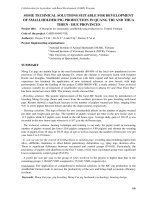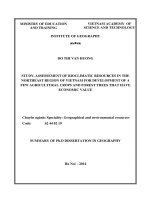Building strategies for development of vietnam national hospital of pediatrics during 2010– 2020
Bạn đang xem bản rút gọn của tài liệu. Xem và tải ngay bản đầy đủ của tài liệu tại đây (1.51 MB, 68 trang )
THESIS MBA
Building strategies for development of Vietnam National Hospital of
Pediatrics during 2010– 2020
TABLE OF CONTENTS
CONTENTS
Page
COMMITMENT
1
GRATITUDE
2
TABLE OF CONTENTS
3
LIST OF TABLES, DIAGRAMS
9
FOREWORD
10
1. Necessity of the research subject
10
2. Research objectives
11
3. Scope of research
11
4. Research methods
11
5. Structure of the subject
12
1
CONTENT PART
CHAPTER 1: BASIC THEORIES ON BUILDING BUSINESS STRATEGIES IN THE
13
ENTERPRISE
1. Basic issues on strategy
13
1.1- A number of concepts on strategy
13
1.2- Characteristics of a strategy
14
1.3- Types of business strategies
14
1.3.1- Classification of business strategies according to their levels
14
1.3.2- Classification of business strategies according to their contents
15
1.3.3- Classification of business strategies their processes
15
1.4- Roles of business strategies
15
1.5- Process of strategy planning
16
2- Contents of strategy building process
17
2.1. Determining the organization’s missions and goals
17
2.1.1- Determining the organization’s missions
17
2.1.2- Determining strategic goals
18
2.2- Analyzing the enterprise’s external business environments
18
2.2.1- Impacts of external environments on business strategies
18
2.2.1.1- Macro environment
19
2.2.1.2- Sector environment
19
2.2.1.3- Number and capacity of enterprises within the sector
20
2.2.2- Evaluating environmental impacts
21
2.3- Analyzing the internal enterprise (analyzing internal environment)
22
2.3.1- Analyzing the organization’s value chain
2.3.2- Analyzing financial codition
22
23
2
2.4- Building and selecting strategies
24
2.4.1- Concentrated growth strategy
24
2.4.2- Integrated growth strategy
25
2.4.3- Diversification-based growth strategy
25
2.4.4- Reduction strategy
25
2.4.5- Mixed strategy
26
2.5- Building level strategies
26
2.5.1- Business strategies
2.5.2- International business strategies
26
26
CHAPTER 2: BUILDING STRATEGIES FOR DEVELOPMENT OF VIETNAM
27
NATIONAL HOSPITAL OF PEDIATRICS DURING 2010 - 2020
1. Overview of Vietnam National Hospital of Pediatrics
27
1.1- Forming and developing process
27
1.2- Fields of operation
27
1.2.1- Treatment
27
1.2.2- Scientific research
28
1.2.3- Training
28
1.2.4- Speciality guidance
28
1.2.5- Education health activities
28
1.2.6- International cooperation
28
1.3- Organizational structure and leading machinery.
28
1.3.1- Organizational structure
28
1.3.2- The hospital’s leaders
30
1.4- State of medical examination and treatment during the past 5 years
30
3
1.4.1- Results of specialized activities
30
1.4.2- Financial operation results
34
2. Analyzing the enterprise’s strategic and managerial matters
34
2.1- External environment
34
2.1.1- Macro environment
34
2.1.1.1- Economic environment
34
2.1.1.2- Political - legal environment
36
2.1.1.3- Technological environment
38
2.1.1.4- Cultural environment
39
2.1.1.5- Social environment
40
2.1.2- Analyzing the sector environment
41
2.1.2.1- Real situation of sector environment
41
2.1.2.2- Summing opportunities and challenges for the environment sector
43
2.1.2.3- Five competitive forces
44
2.2- Analyzing the internal environment
48
2.2.1- Vision
48
2.2.2- Missions
48
2.2.3- Value and philosophy of operation
48
2.2.4- Strategic goals of the hospital
48
2.2.5- The organization’s cultural environment
49
2.2.6- Human resources
49
2.2.6.1- Situation of current human resources
49
4
2.2.6.2- Regime for employees
50
2.2.6.3- Regimes to attract talents and recruit
50
2.2.6.4- Training policies
50
2.2.7- Information technology
51
2.2.8- Finance
51
2.2.9- Scientific research
53
2.2.10- Hospital management
54
2.3. Analyzing strategies through model SWOT
55
CHAPTER 3: STRATEGIC SOLUTIONS AND RECOMENDATIONS
57
1. Strategic solutions
57
1.1- Strategy selection
57
1.2- Reasons for choosing strategy of basing on distinctions
57
1.3- Distinctions
57
1.3.1- Distinctions in science and technology level
57
1.3.2- Distinctions in service quality
58
1.3.3- Distinctions in facilities
58
1.4- Solutions to strategy of making distinctions
58
1.4.1- Strategy of human resources development
58
1.4.2- Intensifying application of science and technology
61
1.4.3- Reforming organization
62
1.4.4- Improving financial capacity
62
1.4.5- Investing in facilities and equipment
63
5
1.4.6- Reputation
65
1.4.7- Broadening international cooperation
65
1.4.8- Intensifying examination and assessment
66
1.4.9- Accomplishing the information system to instruct the strategy
66
implementation
2. Recommendations
67
2.1- For the macro environment
67
2.2- For the sector (micro) environment
68
3. Drawbacks in process in research and research orientation in the
68
future
3.1- The sensitivity of figures
68
3.2- Researching time
69
CONCLUSION
69
LIST OF MATERIALS
71
1. Books
71
2. Other publications
71
3. Websites
72
LIST OF INSTRUCTING ORGANIZATIONS AND INDIVIDUALS
73
6
LIST OF TABLES, DIAGRAMS
Name of table, diagram
I
TABLES
1.1
The organization’s value chain
1.2
The enterprise’s SWOT matrix analysis table
1.3
Table of changes in concentrated growth strategy
1.4
Table of changes in integrated growth strategy
2.1
Composition of the hospital’s Board of Leaders
2.2
Results of medical examination and treatment during the past 6 years
2.3
Results of revenue and expenditure through a number of years
2.4
Compare rates doctors and hospital beds/ children
2.5
Comparison in competitive capacity and market share on the site in 2008
2.6
The amount of patients in 6 years (2004-2009)
2.7
Details of some incomes
2.8
Summary of deduction for establishing funds
2.9
Annual budget for scientific research
2.10
Matrix diagram of SWOT
II
DIAGRAMS
1.1
Process of strategy planning
1.2
Process of business strategy formation
1.3
Model of five competitive pressures according to M. Porter
2.1
Organizational structure of Vietnam National Hospital of Pediatrics
2.2
Number of outpatients
2.3
Number of inpatients
2.4
Occupational efficiency of sick-beds
2.5
Number of operations
FOREWORD
7
Page
22
23
24
25
30
30
34
42
45
47
52
53
54
55
16
17
19
29
31
32
32
33
1. Necessity of the research subject
Under the background of current fierce market, any enterprise wishing to exist and
develop must find its own appropriate direction, and build developing strategies which
comply with external environmental conditions and the enterprise’s internal factors, in
which business strategy is a component and one of the most important bases to build
the enterprise strategies.
Founded in 1969, after 40 years of building and growing, Vietnam National Hospital of
Pediatrics have developed continuously, becoming the leading Hospital specializing in
Pediatrics in Vietnam which provides medical examination and treatment for millions
of patients throughout the country.
However, Vietnam is a young population country having over 86 million people, 16
million of which are children with age under 16 1. The demands for examination and
treatment of people, in general, and small children, in particular, are very high,
especially when the current environmental and climatic conditions change
complicatedly and many new diseases have appeared, threatening the health and life of
small children.
Our country has only 30 hospitals specializing in Pediatrics and Obstetrics 2, in which
there is only 01 national hospital; the remaining ones are provincial and city hospitals,
leading to regular patient overload at other hospitals, especially in summer and winter.
In parallel with the country’s open and developing economy, apart from demands for
high quality health care of Vietnamese people have increased more and more. The
tendency to have demands for medical examination and treatment of diseases at jointventure hospitals and in neighboring countries such as Singapore, Thailand, China,
Korea and even the US has increased.
1
Sources reported the General Statistics Office 2009
2
Home electronic information Ministry of Health
8
To meet demands for examination and treatment of diseases of the people at maximum;
to exist, develop and compete with other hospitals, besides investing in upgrading
infrastructures, applying modern scientific and technological advances in diagnosis,
treatment, etc, building strategies for long-term business development is of great
importance. That is the reason why our group chooses the research subject “Building
strategies for development of Vietnam National Hospital of Pediatrics during
2010– 2020”.
2. Research objectives:
- To systematize a number of theories on building and developing business strategies
for the enterprise.
- To analyse the enterprise’s business environments (micro and macro environments)
during the pas time and in the coming time; to analyse internal factors and potentials;
- To orient business strategies which are suitable for the hospital during 2010 – 2020
and solutions to implement the strategies effectively.
3. Scope of research:
To analyse the business environments of the hosspital from 2004 to 2009 in order to
orient the business strategies for 2010 – 2020.
4. Research methods:
4.1- Method of data collection: Uses both primary and secondary data such as:
- Collection of primary data via such sources as press, television, Internet, the
hospital’s internal documents, reports of health sector and specialized magazines.
- Collection of secondary data: through working meetings with leaders, cadres and
employees currently working at the hospital; interviews with experts in health sector.
4.2- Method of comparison and synthesis:
Comparing an indicator with the basis (original indicator) for data of business results,
market parameters, mean indicators and other comparable indicators. Conditions for
9
comparison are that data must be appropriate in terms of space, time, economic
contents, measuring units, calculating methods, business scales and conditions.
4.3- Method of statistics using tables and diagrams:
The statistics used to find the common trends or characteristics of analysed factors
4.4- Expert method:
Consulting opinions of experts to draw the conclusions.
4.5- SWOT method:
Finding strengths and weaknesses inside the enterprise, opportunities and risks outside
the enterprise. This is the key method in strategy planning.
5. Structure of the subject
The subject is presented in 3 chapters:
+ Chapter 1: Basic theories on building business strategies in the enterprise.
+ Chapter 2: Builing strategies for development of Vietnam National Hospital of
Pediatrics during 2010 – 2020.
+ Chapter 3: Strategic solutions and recomendations.
CHAPTER 1: BASIC THEORIES ON BUILDING BUSINESS STRATEGIES IN
THE ENTERPRISE
1. Basic issues on strategy
10
1.1- A number of concepts on strategy
The term “Strategy” was first and popularly used in military field; according to
American Encyclopedia, “Strategy is a science and art of military management applied
to planning and implementation on the whole scope to gain the final victory”, Today,
the term “Strategy” is popularly applied in business filed. Our group would like to
quote definitions of some authors:
- “Strategy is the pattern of objectives, purposes and plans for achieving those goals”3
(Andrew)
- “Strategy is the determination of the basic long term goals and objectives, and the
adoption of courses of action and the allocation of resources necessary for carrying
out goals"4
(Chandler)
- "Strategy is the direction and scope of an organization over the long-term: which
achieves advantage for the organization through its configuration of resources within
a challenging environment, to meet the needs of markets and to fulfill stakeholder
expectations"5
(Johnson and Scholes)
- “Strategy is the pattern or plan that integrates an organization’s major goals,
policies and action sequences into a cohesive whole"6
(Quinn)
- “Strategy is a harmonious combination of activities and allocation of resources to
achieve goals of an organization. Strategy of an organization is endeavors to make full
3
Kenneth L.Andrew (1965)
4
Chandler, A (1962), Strategy and Structure. Cambrire, Massacchsettes. MIT Press.
5
Johnson, G, Scholes, K (1999), Exploring Corporate Strategy, 5th Ed. Prentice Hall Europe
6
Quinn, J., B (1980)
11
use of the organization’s capacity and resources to deliver the most appropriate
responses to opportunities and challenges of the external environment”7
(Bateman and Zeithaml)
Despite of differences, all of the concepts mentioned above refer to the generality of
predetermined goals, policies and action plans of an organization.
1.2- Characteristics of a strategy
We can realize that there has not been unification among viewpoints on strategy.
However, at any angle, in any period, a strategy still has the most common
characteristics are:
- Business strategies clearly identify basic objectives and business orientations of the
enterprise in each period.
- Orienting nature of strategies guarantee that the enterprise can develop continuously
and steadily in a changing business environment.
- Business strategies guarantee maximum mobilization of capital in combination with
optimum exploitation and use of the enterprise’s resources at present and in the future,
bringing into play advantages and grasping opportunities to gain competitive edges.
- Business strategies of the enterprise are reflected during a continuous process.
- Business strategies always tend to attack and gain advantages in the business world.
- Business strategies are usually built in a long period (3 years, 5 years, 10 years).
1.3- Types of business strategies
1.3.1- Classification of business strategies according to their levels
Each enterprise has 3 levels of strategies, including company-level strategies; business
strategies and functional strategies.
- Company-level strategies (or general strategies): these are the strategies built for the
whole company in all of the fields involving its participation. These strategies aim to
show the destination the company wishes to reach.
7
Bateman và Zeithaml,( 1990)
12
- Business strategies (fields): are built for a specialized business line.
- Functional strategies: these are strategies of each specific function in the company
such as finance, marketing, human resources, etc; functional strategies can be regarded
as supporting strategies to successfully carry out business strategies and company-level
strategies.
1.3.2- Classification of business strategies according to their contents:
Based on contents of strategies, French managers assume that business strategies
include the following types: Commercial strategies; Technological and technical
strategies, Financial strategies, Human strategies.
1.3.3- Classification of business strategies their processes
Business strategies consist of:
- Orienting strategies: deal with major orientations on the enterprise’s goals, directions
and measures to achieve those goals. They are built based on the results of analyzing
environments and the internal enterprise. Orienting strategies provide the strategic
plans for the enterprise.
- Action strategies: are action projects of the enterprise in specific situation and
anticipations for adjusting strategies. Action strategies can be selected from strategies built
while building, orienting strategies and can be selected from strategies emerging during
implementation of orienting strategies.
1.4- Roles of business strategies
- Business strategies help the enterprise clearly identify its purposes and directions,
serving as the basis and guideline for all business and production activities of the
enterprise.
- Business strategies helps the enterprise catch and make full use of business
opportunities, at the same time take active measures to overcome risks and threats in
the competitive market.
13
- Strategies contribute to enhancing effectiveness of resource usage, reinforcing the
enterprise’s competitive position, and ensuring its sustainable development.
- Business strategies create established base for putting forward policies and decisions
on business and production in accordance with market changes.
1.5- Process of strategy planning
Diagram 1.1- Process of strategy planning
The enterprise’s strategic functions,
duties and objectives (1)
Analysis of business
environments (O.T) (2)
Internal enterprise
analysis (S, W) (3)
Selecting strategies (4)
Company-level strategies (5)
Formation
Implementation
Strategies of business establishments and functional
divisions
(to decide what to do)
(to achieve results)
Implementing strategies (6)
Determining opportunities
2. Contentsand
of risks
strategy building process
COMPANY
Enterprise’s structure and
relationships:
:
Although there are various viewpointsSTRATEGIES
and approaches
on formation of strategies, but in short,
Division
of (7)
labor, coordination
Checking and evaluating implementation
results
strategies are usually built according to the following steps:
between sections and
Determining the enterprise’s
information systems.
Types of
Diagram
1.2: of
Process
of business strategy
formation
resources
materials,
objectives and
techniques, finance and
Feedback Process of organization and action
policies
management
defining the
Measuring standards and methods,
company and
system of motive forces
its lines of
Control system
Human values and
business.
determination of Board of
Leaders
Selection and promotion
Company’s highest ranking leader
Affirming non-economic
responsibilities to the
society
14
Strategic nature - labor force
organization
2.1- Determining the organization’s missions and goals
2.1.1- Determining the organization’s missions
In general, the establishment of a mission statement is a continuous process with six
basic steps:
Step 1: Forming initial ideas on business missions.
Step 2: Investigating external environments and recognize internal conditions.
Step 3: Re-determining ideas on business missions.
Step 4: Rebuilding the company's mission statement.
Step 5: Organizing the implementation of the company’s mission statement.
Step 6: Reviewing and adjusting the mission statement.
During building of the mission statement, it is necessary to consider expectations of
owners and leaders as well as the company’s external and internal factors.
2.1.2- Determining strategic goals
15
Goals specify orientations to pursue, having influences on the enterprise’s types of
actions.
Goals also have a central role, being the results of comparison. For each enterprise,
goals can be of long-term, medium-term or short-term types. Economists assume that
an enterprise fixes its goals in the following 8 main fields: Market position; Innovation;
Productivity; Financial resources and logistics; Profits; Cadres’ development and
performance; Workers’ attitudes and performance; Responsibilities to the society. If 1
of the 8 fields mentioned above is lacked, there will appear serious consequences for
the whole enterprise. In order for the fixing of short-term goals not to harm long-term
goals, there must be a balance between these goals.
2.2- Analyzing the enterprise’s external business environments
2.2.1- Impacts of external environments on business strategies
External environments are factors which can cause influences on fulfilling the
enterprise’s expected goals. Analyzing external environments includes analysis of
macro environment and sector (micro) environment. Analysis of these factors helps the
enterprise determine its position and environmental characteristics, the age in which it
exists, identify influences of external environments on the enterprise and its goals, thus
making decisions on strategic planning.
2.2.1.1- Macro environment:
Macro environment consists of various factors which have indrect influences on the
enterprise’s activities through its impacts on factors belonging to sector environments,
five of which are evalulated by managers to be factors having the most drastic impacts
including economic factors, institutional factors, legal factors, social factors, natural
factors and technological factors.
2.2.1.2- Sector environment:
Is the environment closely related to the enterprise’s activities; factors of operation
environment will determine investment environment, competitive intensity and profit
rate within the sector.
16
Diagram 1.3 : Model of five competitive pressures according to M. Porter8
Risks from potential
competitors
Negotiating
capacity of
suppliers
Competition
between
competitors
within the sector
Negotiating
capacity of
buyers
Threat of
substitutes
- Potential competitors: are enterprises which are currently not participating in
competition in the sector, but are likely to penetrate into the sector. The appearance of
these competitors will increase competitive intensity, and reduce profit rate in the
sector. The ability to penetrate of these potential competitors depends on barriers for
penetrating into the sector; if barriers to entry are great, the ability to penetrate will
reduce and vice versa. According to Joe Bain9, There are three main barriers to entry:
customer loyalty to the company’s products, absolute advantage of cost and economies
of scale. If an enterprise has strategies to raise barriers to entry, it will restrict the risks
due to penetration of potential competitors.
8
M.E. Porter, Competitive Strategy(New Yok: Free, Press, 1980)
9
J.E. Barriers to New Competition (Combridge, Mass: Harvard University Press, 1956) For a review of the
modern literature on barriers to entry, see R,J Gilbert, “Mobility barriers and value on Incumbency” in R.
Schmalensee and R.D. Willig, Handbook of Industrial Organization, (Amsterdam,, Holland 1989),I.
17
- Current competitors:
Competitors are regular pressure and directly threaten enterprises. When the
competition of enterprises existing in the sector rises, there will be more threats to the
earning capacity, existence and development of the enterprise because this competition
causes the enterprise ton raise investment cost in order to differentiate its products,
services to access to market or reduce cost price.
2.2.1.3- Number and capacity of enterprises within the sector:
Number and capacity of enterprises within the sector determine competitive nature and
intensity within the sector. In a sector with high number of enterprises and equal
capacity, competition tends to happen violently and lean more to price war. In case
there are few dominant enterprises, these enterprises usually unite with one another to
control the market and the less dominant companies often have to comply with the
rules of the game set by leading enterprises.
Market demands: demands for the enterprise’s products and services have great
impacts on competitive intensity. When demands for product tend to increase,
enterprises will find it easier to protect or expand their market share, competitiveness
will be less fierce; however, when demands tend to decrease, enterprises wishing to
protect their market share and expand the market will indispensably have to take part in
a fierce war with other enterprises.
The higher this cost is, the more difficult enterprises will find it to get out of the sector;
therefore, enterprises will have to be determined to fight for existence. That makes
competitive intensity increases more and more, especially in mature or declining
periods. On the contrary, if exit barriers are low, competitive intensity within the sector
will tend to decrease.
Besides the factors mentioned above, competitive intensity also depends on other
factors such as differentiation of products and services among enterprises within the
sector, the sector’s growth rate, bet on the sector, fixed cost, etc.
18
2.2.2- Evaluating environmental impacts
To evaluate environmental impacts, people usually use the method of quantifying
impacts of environmental factors on the enterprise’s activities; then, those factors will
be synthesized. This process is performed through five steps:
Step 1: Making a list of factors which have decisive roles to the enterprise’s success.
Step 2: Determining each factor’s importance to the sector.
Step 3: Determining significance of each factor in relation to the ability to respond of
the enterprise’s current strategies or importance to the enterprise.
Step 4: Calculating points of each factor.
Step 5: Totalling points.
After totalling points, we will realize environmental impacts on the enterprise,
determine opportunities and challeges the enterprise has to overcome. This is the basis
to build business strategies in order to ensure strategies’ compliance to environments
and movements.
2.3- Analyzing the internal enterprise (analyzing internal environment)
The enterprise's ability is a basic factor determining what the enterprise can do,
whether its strategies can be successfully implemented. To ensure feasibility of
strategies, when building strategies, we have to evaluate real situation, determine
strengths and weaknesses, thereby define the enterprise’s differentiating ability or
competitive advantages. Internal analysis is porformed in the following aspects:
2.3.1- Analyzing the organization’s value chain
Table 1.1 The organization’s value chain10
Supporting
activities
10
Infrastructure
Information system
Human resource
Material management
Research and development
/>
19
Strategic
goals
Main
Marketing
activities
and sale
After-sale
Production
services
Value chain is a combination of the enterprise’s activities in order to increase values.
The organization’s value chain is made up of two types of activities: main activities
and supporting activities.
Main activities are activities closely related to the enterprise’s products and services.
They include purchasing activities, input factor management activities, marketing
activities for services and subsequent customer care actitvities.
Supporting activities help main activities to be carried out more successfully and
effectively. Activities we are referring to are human resource management,
technological development and purchasing activities.
2.3.2- Analyzing financial codition
One important and indispensable part is result of business activities through the
enterprise’s financial indicators. Via calculation data about the analyzed financial
indicators, we will have a clear insight into financial ability, planning and management.
Besides the factors mentioned above, internal analysis include such issues as
sustainable values, internal control as well as control of risk factors in investment
analyzed and evaluated depending on level of activities.
Upon completion of internal analysis, we have to make a summary table of the enterprise’s
strengths and weaknesses. This is the final work and also the result of internal analysis stage.
20
The summary table of strengths and weaknesses is made based on principles of the
summary table of opportunities and challenges in environment analysis part.
Upon combining the two summary tables mentioned above - opportunities and
challenges; strengths, weaknesses - we get the result for analysis and synthesis of
strengths and weaknesses, opportunities and challenges (SWOT matrix). This is the
final expected result of environment and internal analysis, at the same time, is the
premise for the enterprise’s strategic planning.
Table 1.2: The enterprise’s SWOT matrix analysis table11
Opportunities
Challenges
Strengths
S/O combination
S/T combination
Weaknesses
W/O combination
W/T combination
combination
Based on SWOT matrix, the enterprise will find strategies to bring into play strengths,
overcome weaknesses, make full use of opportunities and avoid challenges set by the
environments.
2.4- Building and selecting strategies
Strategy is a system of major policies and measures in order to deploy and coordinate
action plans, helping the organization fulfill its goals most effectively. Company-level
strategies are strategies covering the whole activities of the company, aiming to
compete most effectively, dominate the market, and ensure sustainable development.
2.4.1- Concentrated growth strategy:
In pursuing this strategy, the enterprise’s strategies focus on improving products or
markets without changing other factors. The enterprise will try to exploit every
opportunity gained for the current products and services or operating markets.
Table 1.3: Table of changes in concentrated growth strategy12
11
/>
12
/>
21
Products, services
Markets
Currently or newly
Current or
implemented
new
Sector
Sector’s level
Technology
Current
Current
Current
The concentrated growth strategy allows the enterprise to focus all of its efforts on the
operating fields of strengths, exploit outstanding strengths to develop business.
However, the concentrated growth strategy omits the opportunity to expand markets
without using up the enterprise’s remarkable performances, catching development
opportunities of other sectors.
2.4.2- Integrated growth strategy:
Enterprises, in pursuing this strategy, will find measures to undertake the input factor
production or product consumption stages. Implementing the integrated growth
strategy, enterprises can make forward or backward integration, total integration,
internal or external integration.
Table 1.4: Table of changes in integrated growth strategy
Products, services
Currently implemented
Markets
Current
Sector
Current
Sector’s level
New
Technology
Current
Integrated growth strategy help the company save cost and reduce costs of markets,
better control quality, make full use of business opportunities and become more active
in planning business and production projects. This strategy can be applied to capable
enterprises catching opportunities which are suitable for their long-term goals.
2.4.3- Diversification-based growth strategy:
An enterprise pursuing diversification-based growth strategy will implement measures
to develop its new products, services and dominate new markets in order to improve
22
the operation effectiveness. Diversification strategies make full use of the surplus
financial resources, create new competitive advantages, and restrict risks, etc.
However, diversification strategies also require the enterprise to improve its
management capability, carefully consider benefits and costs for development in this
direction.
2.4.4- Reduction strategy:
This strategy is very necessary when the enterprise restructure to serve the new period.
The strategy is implemented when business lines pursued by the enterprise do not
remain promising for long-term development, the economy is not stable or more
opportunities that are valuable appear. Reduction strategy aims at reduce costs, and
recover investment capital.
2.4.5- Mixed strategy:
An enterprise, in the same period, can apply various strategies. The enterprise can
promote development in this field while making reduction in another line of business.
Those activities all aim to successfully implement the general goals of the enterprise
during implementation of strategies.
The selection of which strategy among the strategies mentioned above depends on the
enterprise' ability of and related environmental conditions. From result of SWOT
analysis will choose the most appropriate business strategies.
2.5- Building level strategies
2.5.1- Business strategies
For enterprises with single-sectoral business lines, level strategies coincide with the
enterprise's strategies. However, for multi-sectoral enterprises, in each business lines
with its involvement, the enterprise has to build a unique business strategy. Due to
varied features and environmental conditions of each sector is different, development
strategies for each sector cannot be the same.
2.5.2- International business strategies
23
Talking about international business strategies, we usually refer to the two matters
including strategies of penetration into and expansion to foreign markets and strategies
of competition. The matter of competition in international markets also has the same
features as that of competition in domestic markets; however, the competitive extent
and nature of international business strategies are much more competitive than those of
domestic markets.
CHAPTER
2:
BUILDING
STRATEGIES
FOR
DEVELOPMENT
OF
VIETNAM NATIONAL HOSPITAL OF PEDIATRICS DURING 2010 - 2020
1. Overview of Vietnam National Hospital of Pediatrics
1.1- Forming and developing process13
Vietnam National Hospital of Pediatrics was founded in 1969 with the initial name of
the Hospital for Protection of Children’s Health; in June 2003, was officially named
Vietnam National Hospital of Pediatrics.
Vietnam National Hospital of Pediatrics is assigned by Ministry of Health as the
leading unit of the nationwide pediatric system. The hospital is a medical center and
the highest pediatric treatment level throughout the country. At present, the hospital
has had 1,220 cadres and employees; the total number of sick-beds is 850.
Information about the unit:
Name of unit: VIETNAM NATIONAL HOSPITAL OF PEDIATRICS
+ International trade name: VIETNAM NATIONAL HOSPITAL OF PEDIATRICS
+ Abbreviated name: NHP
+ Head office: No. 18/879, La Thanh Street, Dong Da District, Hanoi
13
www.benhviennhitu.org.vn
24
+ Tel: +84.04.38343 176; +84.04 37755 335; Fax: + 84.043 7754 448
+ Email:
+ Website:
1.2- Fields of operation
1.2.1- Treatment:
The hospital has 23 clinical specialties. Annually, there are about 45,000 inpatients,
and 450,000 outpatient visits. This figure increases from 10 to 15% after each
year. Each year, the hospital performs over 14,000 major operations.
1.2.2- Scientific research: The hospital is the leading Pediatric scientific research
center of the whole country. A lot of State-level, Ministry-level and grassroots level
research subjects have been conducted annually.
1.2.3- Training: The hospital has coordinated with Pediatric Department of Hanoi
Medical University in training Pediatric students, level I, level II specialists, Pediatric
M.As and Doctors. Annually, the hospital coordinates with international pediatric
centers to organize from 20 to 25 training classes on updating Pediatric knowledge for
Pediatric doctors and nurses throughout the country, train, transfer technology for
doctors of many countries in the region such as Laos, Thailand, Malaysia, Philippine
and in the world like France, USA, Italia.
1.2.4- Speciality guidance: As a leading Pediatric organization, the hospital has
focused on guiding the sector in the direction of carrying out primary health care and
improving quality of diagnosis and treatment. In recent years, the hospital has
concentrated on guiding to improve the quality of emergency system and strive to
reduce newborn mortality rate to the lowest level.
1.2.5- Education health activities: Education on nursing children, consultancy on
juvenile health, disease prevention have been conducted by the hospital in many
forms: organization of workshops, conversations, presentation about special subjects
on the communication media (radio stations, television), etc.
25









